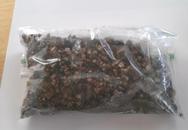DIYSampleTesting.com
Collect and Submit Your Own Samples and Save!
Sample testing services offered by
a fully accredited laboratory
Frequently Asked Questions-Asbestos Testing
Q: My floor tile is 9 inch by 9-inch ("9x9"). Do I need to test it? Doesn't 9x9 tile always contain asbestos?
A: Not necessarily. The thick 9x9 floor tile manufactured in the late 1940s and 1950s almost always contains asbestos. However, some flooring manufacturers began to discontinue adding asbestos to floor tile in the 1960s. In some cases, they began using a lower grade of "asbestos," consisting of finer fibers and non-fibrous "asbestos parent material." In some cases, the low level presence of asbestos in tile may have been merely a manufacturing contaminant. This reduced use of asbestos means that some types of asbestos tile when tested, come back as containing an unregulated trace amount of asbestos (<1%). In this case, the floor tile can be treated as non-asbestos except where extremes disturbances of the tile are anticipated (e.g. scarification or sand-blasting of tile off a floor). We tested one customer's Kentile-brand 9x9 floor tile from a box clearly labeled "asbestos floor tile" that was manufactured in the early 1970s. The results indicated the tile could be treated as non-asbestos as the concentration was consistently below the limit of 1% (0.05-0.75%).
Q: My floor tile is 12 inch by 12-inch ("12x12") with a yellow mastic. Do I need to test it? Isn't newer 12x12 tile always non-asbestos?
A: Not necessarily. Clearly 12x12 tile with newer yellow mastic is less likely to contain asbestos than tile with older black mastic. Yellow mastic began to replace black mastic in the 1980s. This inspector last saw asbestos floor tile for sale in a hardware store in Lima, Ohio in 1989. There are anecdotal reports that some of the big box stores inadvertently sold 12x12 asbestos floor tile imported from overseas manufacturers in the mid-2000s.
Q: My laboratory report identifies my floor tile as non-asbestos but it comes with a disclaimer at the bottom? Can I be comfortable with result?
A: Generally speaking, yes. Floor tile reports include a disclaimer that matrix interferences may yield false or negative results. It recommends confirmatory testing to prove the absence of asbestos by a more expensive and sensitive "SEM" or "TEM" test method. EPA has been aware of the limitations of the standard test method but have never made additional testing a requirement, even in schools. This reflects the fact that method limitations pertain to separating closely bound fibers and detecting fibers of short length and smaller diameter. These types of fibers pose a lower risk. In addition, the sample preparation stage may result in the generation of more fibers from non-fibrous asbestos parent material that may be present in the sample, resulting in a potential "false positive" result. We can offer this additional analyses upon request. However, it is not recommended unless unusually extreme disturbances are planned for the tile (e.g. scarfication or sand-blasting).
Q: EPA does not recommend testing of vermiculite attic insulation (VAI). Why do you offer asbestos VAI testing?
A: Its true that there are some limitations in accuracy in the test methods involved and they are not necessarily "legally defensible." However, laboratory methods, while not perfect, have improved. There are some valid technical arguments about whether some fibrous contaminants found in VAI are legally defined as "asbestos." We utilizes a laboratory that utilizes a conservative approach. The results of detecting asbestos VAI ( in about 80-90% of the samples) generally mirrors the estimates that 80-90% of VAI contains asbestos and the remaining VAI was imported from mines that were not contaminated with asbestos. In some cases , the arguments for the method limitations are moot. The test method does not detect asbestos that is bound up in the coarse grains of VAI that is therefore not technically asbestos until the grains are crushed and fibers are formed.
Q: I bought a home test kit not realizing that did not include the cost of the analyses. Can I send the sample to you rather than the laboratory specified in the test kit?
A: Yes. For one sample, you will pay slightly more using www.DIYsampletesting.com but it will include interpretation and guidance for the result. For multiple samples, it will usually be less expensive.
Surprise!. This customer's Kentile "asbestos floor tile" actually did not contain a regulated amount of asbestos and therefore was determined to be "non-asbestos."
A sample of VAI. the darkened color is reflects the customers care in wetting the material before sampling
Q: I bought a home test kit, mailed the sample to the lab and obtained a test result that I do not understand. Can you provide interpretation or second opinions on laboratory reports provided by others?
A: Yes. An interpretation and second opinion letter can be provided for the same cost as the analyses, starting at $55 for one to two week turnaround.
Old wooden sash windows pose a potential dual threat from asbestos in the deteriorated putty glazing and lead dust from the deteriorated paint





